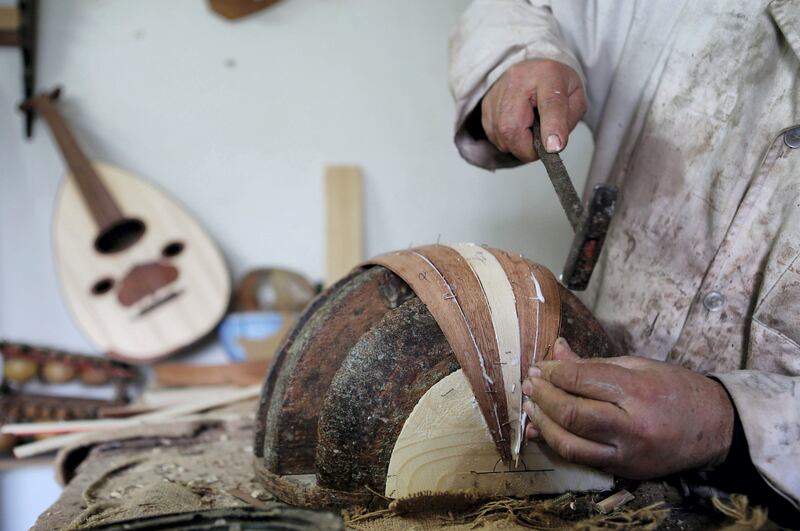Antoun Tawil, one of Syria's last traditional lute makers, waits in vain in his Damascus workshop for orders of the oud, an instrument his country was once renowned for producing.
The civil war that has ravaged Syria over the past six years has devastated many of its historic crafts but production of this oriental lute has been hit harder than most.
Lute-makers have emigrated in large numbers and the Damascene wood used to build the instrument is also now hard to find.
"There were around 20 workshops before the crisis, between Damascus, Aleppo and Hama... Now there are no more than six," says Tawil. Four of them are in Damascus.
The 57-year-old craftsman is among the last of his kind in Syria. In his nine-square-metre shop in Tekkiyeh Sulaymaniyeh, an Ottoman complex made up of a mosque and a crafts market, Tawil contemplates the ouds hung around him.
Some are richly decorated, delicately inlaid with mother-of-pearl and ivory.
All six craftsmen in Tawil's two workshops have now fled to Syria.
"Before the crisis, we opened at five in the morning and worked all day long because there was so much demand," he says wistfully.
In a single month, Tawil used to sell a dozen ouds, many of them destined for abroad including Europe and Canada. "Nowadays, a month goes by without selling anything."
With the Syrian pound's devaluation, prices have also plummeted. "I used to sell an oud for 5,000 Syrian pounds [US$100/Dh367]. Today, I sell them for 35,000 [US$70/Dh257]."
He talks passionately about the Syrian, specifically Damascene, oud, which he describes as both the most exquisite but also the most durable of Arab lutes. "Our ouds can last 70 years without needing maintenance," he says, with a proud smile. "I've made pieces as beautiful as a Persian rug."
________________
Read more:
Memory of the Emirati Song series returns with Hazza Abdullah Al Dhanhani at Al Jahili Fort
Oud virtuoso Naseer Shamma on the growing Sharjah World Music Festival
Love and Revenge: the golden age of Arabic cinema taken to modern day stage
________________
The secret to the oud's durability lies in the first steps of the craft, according to Issa Michel Awad, an expert in the oud and other stringed instruments at the Higher Institute for Music in Damascus.
"It's the way the Damascene wood is chosen, the way it is dried and cured," he says. "That is why you can still play a Damascene oud dating from 1990 today without a single false note."
But in Syria today, it is precisely this treasured wood that poses a problem.
"We rely on walnut wood, which is very high quality and is specifically available in Eastern Ghouta," says Ali Khalifeh, a lute-maker in Damascus.
Eastern Ghouta is a rebel bastion east of the capital, under government siege and beyond the craftsmen's reach.
"Today, this wood is being used by people in Ghouta for heat... It is becoming rare,"
he says.
The first Damascene oud was produced in 1897 by Abdo al-Nahhat, who became one of the country's most renowned lute-makers.
In the early 20th century, the oud was the favoured instrument among Syrians, played at marriages or during gatherings of female socialites.
Khalifeh's atelier in the Adawi neighbourhood is now half-artisanal, half-mechanised.
Ironically, he has found demand has increased for his products because of the few competitors left.
While Tawil uses steam to individually shape the oud's ribs by hand, Khalifeh's workshop uses machines to bend 20 at a time and to smooth the wood. The neck's pegs are screwed in by hand.
"Polishing the oud by hand takes between five and six hours. With the machine, it's done in 15 minutes," says Khalifeh, who exports across the Middle East, France and the United States.
"We used to make 10 to 15 ouds a month, now we make 20," says Khalifeh, who learned the profession from his father at the age of 14.
But even with his own orders up, Khalifeh feels the industry is in terminal decline. "When I look at the state of my profession, I can say it is in the process of disappearing," he says.
Tawil agrees. "It's a profession under threat," he says, lamenting that in addition to the effects of the war, "young people don't have the time to learn".
Like many in the field, he learned the trade from his father and is now passing it on to his daughter.
But he sees a glimmer of hope in the artisans who have emigrated, taking their expertise with them. "In Quebec, there are now Syrians who are opening their own production workshops," says Tawil.
* Agence France Presse





